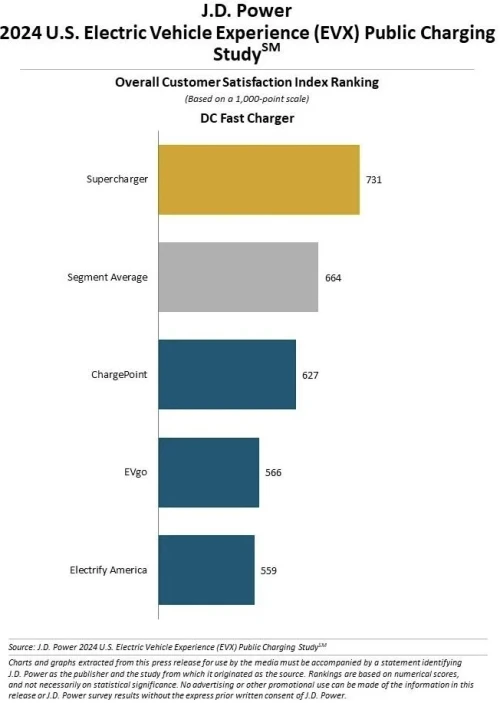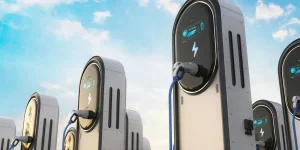The public electric vehicle (EV) charging infrastructure continues to be identified as a culprit in the unexpectedly slow adoption of EVs in the United States, but this year it is showing signs of improvement with overall satisfaction increasing for a second consecutive quarter. While the issue is a long way from being solved, the J.D. Power 2024 U.S. Electric Vehicle Experience (EVX) Public Charging Study suggests the industry is on the right track despite continued challenges.
The number of public charging stations across the country continues to grow but hasn’t matched the rate of EV sales. During the past several years, the rise in the number of EVs per public charging station has contributed to a declining level of satisfaction with such chargers. This year, however, customer satisfaction with the two principal methods of public charging offers a positive sign.
In this year’s study, satisfaction with DC (direct current) fast chargers increases to 664 (on a 1,000-point scale)—a 10-point increase from the same period in 2023. The rise is tempered by the finding that satisfaction with public Level 2 charging has declined to 614, which is 3 points lower than a year ago despite the recent quarterly improvements.

While the customer satisfaction scores for public charging continue to prompt concern, the results offer reasons for optimism. Among users of Level 2 chargers, satisfaction improves in five of the 10 factors that make up overall satisfaction, and among DC fast charger users, satisfaction is up in six of the 10 categories. In addition, the overall indices have improved for the past two quarters. This indicates progress in many areas that EV owners care about, like the speed and availability of fast chargers and the convenience of having other things to do during longer Level 2 charging sessions.
—Brent Gruber, executive director of the EV practice at J.D. Power
The fact that non-Tesla owners can now access the Tesla Supercharger network is one contributor to the increase in satisfaction with DC fast chargers. Previously, Tesla’s extensive network of its proprietary DC fast chargers was reserved exclusively for owners of Tesla vehicles but having qualified for access to multi-billion-dollar federal infrastructure funding has prompted the automaker to allow access to owners of other EVs. For the first time, the study has been able to quantify the effects, analyzing the responses of Tesla and non-Tesla EV owners in specific factors that influence satisfaction.
Overall, both Tesla and non-Tesla owners find charging their vehicles at Tesla Supercharger facilities is most satisfying. Non-Tesla owners—like those with EVs from Ford or Rivian who now have access to the Supercharger network—appreciate the ability to charge at the broad network of Tesla chargers that was previously unavailable to them. Despite the recent influx of non-Tesla vehicles into the Supercharger facilities—which has caused some grumbling—Tesla owners still appreciate the ease of charging and ease of payment that the network offers. However, since the beginning of the year, J.D. Power has seen a decline in satisfaction with the availability of Superchargers among Tesla owners.
—Brent Gruber
Tesla owners remain satisfied with the Tesla Supercharger network, as evidenced by a score of 743, down just 2 points from 2023. Non-Tesla owners are not quite as satisfied when using a Tesla Supercharger (706), but that score is 42 points higher than the overall satisfaction with DC fast chargers.
The biggest gaps between the satisfaction of Tesla and non-Tesla owners come in ease of payment and ease of charging. Tesla offers its owners a virtually automatic plug-and-pay ability not yet available to non-Tesla owners. Its Supercharger network is compatible with Tesla connectors, while current non-Tesla vehicles require the use of an adapter as part of the charging process.
Following are key findings of the 2024 study:
- Satisfaction with charging speed varies by charger type: EV owners seem to have less patience for Level 2 public charging, while simultaneously growing more satisfied with charging time at DC fast chargers. The attribute of speed of charging at Level 2 chargers has declined 4 points to 451 this year. EV owners are not especially happy with DC fast charger charge times either, but the attribute achieves a score of 622, up considerably from 588 in 2023.
- EV owners favor automatic payment: While those who drive conventional internal combustion engine (ICE) vehicles seem content to buy gasoline with a credit or debit card, EV owners are better satisfied by other payment methods. The most satisfying is using an automatic payment system, such as Plug & Charge, that identifies and authenticates the vehicle and connects it directly to billing, allowing EVs to connect to a charge point and immediately begin charging. Satisfaction for those systems is 886 for ease of payment and 806 for ease of charging. Satisfaction among owners who use a manufacturer’s mobile app is 860 for ease of payment and 787 for ease of charging. Satisfaction among EV owners using a credit or debit card is lowest in ease of use (631) and ease of charging (596).
- Non-charge visits remain an issue: The study finds that 19% of all EV owners say they visited a charger but were not able to charge their vehicle, a scant improvement of a single percentage point from 2023. Though the reasons for inability to charge vary somewhat by region, the predominant problem nationwide is the charger was out of service or just wouldn’t work, which affected 61% of the failed visits. Lack of charger availability and/or over-long wait times was an issue affecting 20% or more of EV owners who experienced failed charging visits in the Middle Atlantic, Pacific and East North Central regions. Damage to the cable or connector was another notable reason for a non-charge result, affecting 10% of owners who had a failed charging visit.
While this year’s study points to hopeful signs that the industry is moving in the right direction, concerning issues remain. Too often public charging is not a satisfying experience for EV owners. One issue is sheer availability. Sadly, the growth of public chargers, and especially DC fast chargers that EV owners increasingly favor, is not keeping up with the number of EVs in service. Another concern is theft and vandalism. Some charger facilities are experiencing a high rate of cable damage or theft which, for example, account for 14% of charging failures in the Mountain region. This further exacerbates the issue.
—Brent Gruber
The US Electric Vehicle Experience (EVX) Public Charging Study, now in its fourth year, measures EV owners’ satisfaction with two types of public charge-point operators: Level 2 charging stations and DC fast charger stations. Satisfaction is measured across 10 factors (in order of importance): ease of charging; speed of charging; physical condition of charging station; availability of chargers; convenience of this location; things to do while charging; how safe you feel at this location; ease of finding this location; cost of charging; and ease of payment.
The study is driven by a collaboration with PlugShare, the EV driver app maker and research firm. The study examines consumer attitudes, behaviors and satisfaction, setting the standard for benchmarking the overall experience of public EV charging. Respondents included 9,605 owners of battery electric vehicles (BEVs) and plug-in hybrid electric vehicles (PHEVs). The study was fielded from January through June 2024.
Source from Green Car Congress
Disclaimer: The information set forth above is provided by greencarcongress.com independently of Alibaba.com. Alibaba.com makes no representation and warranties as to the quality and reliability of the seller and products. Alibaba.com expressly disclaims any liability for breaches pertaining to the copyright of content.




